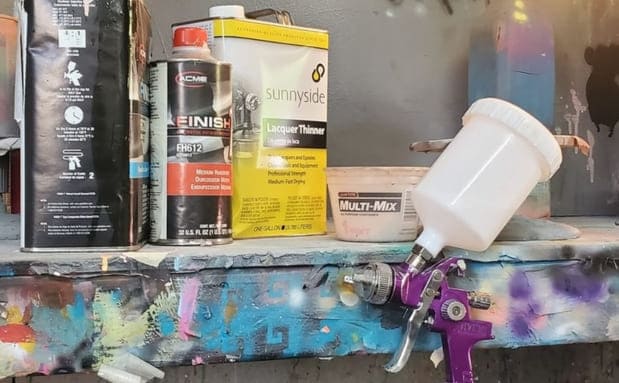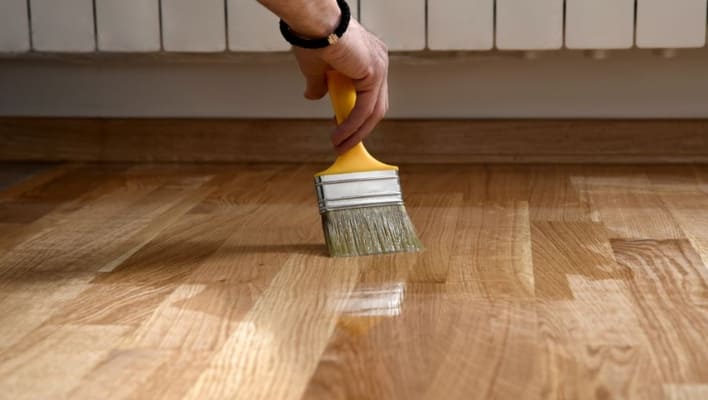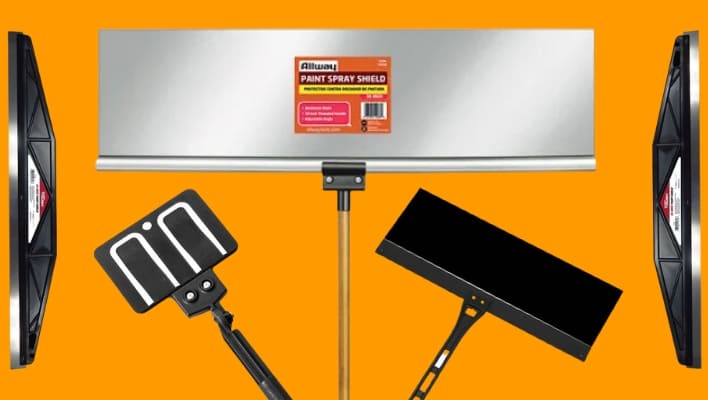Painting a home is not just a home decor project, but it’s a feeling. Everyone knows that paints are prepared by adding specified amounts of solvents, additives, resins, and other necessary ingredients. Paint thinner is also a term used with paints. It’s a broad-ranging term, and usually, different kinds of solvents work as paint thinner. Nevertheless, a question still remains confusing: how to use paint thinner?
The primary use of thinner is paint removal, but the condition is that the paint layer should be thin. Not only surface, but thinner is also a great paint removal agent from brushes, rollers, and other painting accessories. The chemicals which act as thinner are acetone, turpentine, toluene, naphtha, and xylene. In a nutshell, these are perfect paint thinner alternatives.
With the help of this guide, you will have everything you need to know about paint thinners.

A safety reminder: When handling paint thinners or solvents, ensure your safety with proper attire: wear gloves, safety glasses, and a respirator. There is a possibility that these substances can harm your skin, lungs, and organs so protect yourself from inhalation, ingestion, and skin contact with fumes. Headaches, nausea, fatigue, and other symptoms may occur as a result. You should maintain ventilation by opening windows or using fans. These solvents are highly flammable; keep sparks and heat sources away. For paint thinners, don a long-sleeve shirt, pants, closed-toe shoes, goggles with a rubber seal, and respiratory protection.
Table of Contents
- How To Use Paint Thinner To Remove Paint?
- Step 1: Clean The Spills
- Step 2: Wipe off The Thinner
- Step 3: Clean The Painting Accessories
- Step 4: Remove Undesirable Lacquer
- How to Use Paint Thinner to Thin Out Paint
- Choose the Right Type of Paint Thinner
- Mixing Ratios
- Gradual Mixing
- Test and Adjust
- Consistency Matters
- Application Techniques
- Cleaning Up
- Dispose of Waste Properly
- Storage
- How To Use Paint Thinner To Clean Brushes?
- ● Take Paint Thinner In A Container
- ● Clean The Painting Tools
- ● Remove Paint Thinner
- ● Clean The Used Objects
- What Is A Paint Thinner?
- What Is Paint Thinner Made Of?
- ● Toluene
- ● Acetone
- ● Turpentine
- How Much Thinner Do I Add To Paint?
- Uses Of Paint Thinner
- How To Use Paint Thinner For Oil Paints?
- How To Use Thinner To Remove Paint From Clothes?
- How To Use Paint Thinner To Remove Paint From Wood?
- How Do You Use Paint Thinner To Remove Dried Paint?
- How To Use Paint Thinner To Remove Paint From Metal?
- FAQs On How to Use Paint Thinner
- What does a paint thinner do?
- What kind of paint needs paints thinner?
- How do you clean paint with thinner?
- Do you mix paint thinner with water?
- Can I remove the paint with paint thinner?
- Final Words On How to Use Paint Thinner?
How To Use Paint Thinner To Remove Paint?

Paint thinner is consistently used to remove paints, for example, lacquers, and oil-based paints. Check out the easy step to remove paint using paint thinner but don’t forget to wear a face mask and gloves as a safety precaution to avoid the effects of paint thinner on skin.
Step 1: Clean The Spills
Inspect all the areas of a carpet or floor and clean the spills with a thinner. Take a soft cloth or cotton swab for a thinner application. Don’t leave any area, even small or big.
Step 2: Wipe off The Thinner
After that, spot the areas where you have applied the paint thinner with a paper towel. Now it’s time to clean it. Prepare a soapy mixture of warm water and dishwashing liquid. Again take the soft cloth and wipe the spotted areas.
Step 3: Clean The Painting Accessories
Take the accessories and dip them into the solution. Don’t forget to add a significant amount of thinner to the solution. Soak the brushes or rollers and wait for a while. If the paint is still stuck on the surface, use a comb or bristle brush for it. You can also use shampoo if the brush fabrics are delicate and may get affected by the thinner. Further, keep them in the open air for drying and store them after wrapping.
Step 4: Remove Undesirable Lacquer
Take steel wool, dip it in the thinner and remove paint from unwanted areas. Cross-check the things, and there should not be a small spot left behind. If you face any difficulty, remove the paint with a scraper after applying thinner.
How to Use Paint Thinner to Thin Out Paint
The use of paint thinner to thin paint can be a helpful technique for achieving the desired consistency and coverage. This is when working on various painting projects. Paint thinner, also known as mineral spirits or turpentine, is a solvent that can be mixed with paint to reduce its thickness and viscosity.
Working with oil-based paints, enamels, and varnishes can yield excellent results, but it’s crucial to adhere to proper guidelines for safety and achieving the desired outcomes.
Choose the Right Type of Paint Thinner
There are different types of paint thinners available, such as mineral spirits and turpentine. The choice of the appropriate paint thinner is essential, and it depends on the specific type of paint you intend to use.
In the case of oil-based paints, mineral spirits are commonly used, while for fine art oil paints, turpentine is more suitable.
Mixing Ratios
When determining the mixing ratio, start by introducing a small quantity of paint thinner into the paint. Blend the mixture to ensure it is completely mixed. The amount of paint thinner to paint varies depending on the brand and type of paint, and it also depends on the consistency desired. As a general guideline, a ratio of 3:1 or 4:1 (maintaining a higher proportion of paint than paint thinner) is a good starting point. If you need to adjust the ratio to achieve the desired thickness, you can do so as needed.
Gradual Mixing
Start with a small amount of paint thinner and mix it into the paint slowly, while continuously mixing. The primary objective of this technique is to achieve a comprehensive and uniform amalgamation of the paint and the chosen thinner. If you add too much thinner at once, you may result in over-thinning the paint, which may lead to the paint’s performance being affected.
Test and Adjust
When using the thinned paint, do a test run on a scrap piece of paper or canvas before you apply it to your project to make sure it is consistent and covers the area you want to paint. In the case of too thick paint, add a little bit of paint thinner at a time until you achieve the desired flow and coverage with the paint. If you feel that it is too thin, then you might want to add a bit more paint to the mixture.
Consistency Matters
It is ideal to thin thinned paint to the consistency of milk when it is thinned. It should flow smoothly from your brush or roller without clumping or excessive drips. Adding too much paint to the paint can lead to a reduction in the color intensity and a compromised level of coverage.
Application Techniques
Thin paint is well-suited for glazing and washes techniques. It is important to use smooth and controlled brush strokes when applying thinned paint in order to achieve an even finish. You may need to apply multiple thin coats of the product in order to achieve optimal coverage, so keep this in mind.
Cleaning Up
It is important to clean your sprayer, brushes, rollers, and other painting tools as soon as possible after using paint thinner so that the paint thinner does not dry on them. It is recommended that you thoroughly rinse the tools with water or with an appropriate cleaning solution to remove any remaining paint or solvent that remains.
Dispose of Waste Properly
The disposal of paint thinner is considered hazardous waste, and it should be handled according to local regulations when the waste is disposed of.
“Cody Herbert, Manager of Discount Dumpster, emphasizes that hazardous chemicals like paint thinners shouldn’t go in dumpsters due to harm to landfills and the environment. If it’s a problem for a landfill, it’s a problem for a dumpster too. Responsible disposal of hazardous materials is vital for environmental safety.”
Storage
For safe storage, make sure to retain paint thinner in its original container. Seal the container securely and store it away from direct sunlight as well as any potential sources of heat. Do not allow your children or pets to have access to it.
How To Use Paint Thinner To Clean Brushes?

After finishing a painting project, it’s necessary to clean them properly for further use. Follow the steps mentioned below to clean the painting tools:
● Take Paint Thinner In A Container
Take a small bucket or a container and pour thinner into it. The quantity should be enough to dip the cleaning tools in it. Dip paint brushes, rollers, or other items in the bucket and wait. We don’t recommend using plastic containers because there may be a problem with the container after pouring thinner in it.
● Clean The Painting Tools
To remove the paint accurately, scrub the paint brushes and rollers with your hands. You can use a scraper to remove paint from other tools. Don’t forget to wear gloves while working.
● Remove Paint Thinner
After that, make a warm water solution using soap. Dip the tools in it to remove all the thinner residue left behind. Rinse it well and dry the tools in the end.
● Clean The Used Objects
After finishing, it’s time to clean the used items and objects. Clean the rag, paint trays, cans, and other objects using a dry cloth.
So, these are the simplest steps about how to use paint thinner to remove paint from brushes. You don’t need long preparations and expensive tools for it.
What Is A Paint Thinner?
A paint thinner is a solvent that is specially prepared for paint removal from walls, wood, floor, paint brushes, or rollers. It’s also used to get rid of paint on clothes and carpets. The other applications include degreasing the bike and car spare parts.
Likewise, a paint thinner is also used to thin the paint if your paint is thick. The most common application is found in sprayers. If you want to use a sprayer for painting, a thinner helps you thin the paint easily.
Thinners are mineral spirits prepared with a different combination of chemicals. It is to be noted that some thinners work better, and others are light; it all depends on the type of thinner used.
What Is Paint Thinner Made Of?
Paint thinners are prepared from the following ingredients:
● Toluene
Toluene is also a good thinner if used alone. It is extracted from the tolu balsam tree, and that’s why it is called toluene. People also get it from crude oil, and it’s an extremely flammable liquid. Don’t inhale it; otherwise, it may cause serious injuries like nausea, dizziness, irritation, tiredness, and more.
● Acetone
Acetone is widely used as a thinner for common applications, i.e., nail polish remover, wood polish remover, etc.; if you want to clean the accessories, using acetone to remove paint from metal is a better option. Likewise, it has no health hazards but is a highly flammable liquid.
● Turpentine
Drawn from pine trees and widely used for making different types of varnishes. It’s a highly flammable compound; manufacturers always advise keeping it away from heat sources. Its vapors are also toxic and can cause eye/ear irritation. If you breathe in turpentine for longer, your whole nervous and respiratory system may be at risk. Kidney failure may also occur.
How Much Thinner Do I Add To Paint?
Knowing the right proportion of thinner is also necessary to perform the job perfectly. For general purpose paint removal, the suggested proportions of thinner are 3:1 or 4:1. If you want to thin the paint, the paint amount will be more than the thinner.
If the amount of paint is thin then it may cause the color to be dull a little; therefore, don’t add a thinner too much to it. The amount of thinner also depends on the paint used and other parameters.
Paint thinners also have applications to make the paints thin. First, you have to pick up a suitable paint thinner according to the paint type you are going to use. Remember that different paints require different paint thinners to make a perfect combination.
After that, mix the paint and thinner in a specified proportion to make the paint thin. You can also take a little amount of paint in a separate bucket for testing purposes. Further, apply that thin paint to your desired surface and test. If the proportion is according to your requirements, go further; otherwise, repeat the process again.
Uses Of Paint Thinner
- A paint thinner can be used to thin paint, i.e. reduce its viscosity, so that paint can be applied with sprayers.
- They are useful for removing paint from brushes and rollers, as well as removing paint from spills.
- Paint thinner can also be used to clean your tools once your job is done, especially if you used oil-based paint.
How To Use Paint Thinner For Oil Paints?
Oil-based paints bring several benefits to home décor projects. It’s a fact that such paints are thicker and hard to apply on the walls or other surfaces. Therefore, oil-based paints need to be thin before application. Whether you are using brushes or sprayers, paints need to be thought of before application.
Thinner is a perfect solvent for thin oil paints and primers. The procedure is pretty easy, just pour the thinner into the paint and stir well. The quantity depends on how thin you want the paint to be.
How To Use Thinner To Remove Paint From Clothes?
If you got some paint spots on your clothes, don’t worry, you can remove them by following the simple steps below:
- First, try to scrape the paint by hand if dried.
- If the paint is wet, you can take a cloth to wipe it properly. It’s better to dip the cloth in warm water first.
- Use laundry detergent or dish soap and use a soft brush to scrub the spotted area.
- Don’t need to apply too much force; wash it like ordinary clothes.
- In case some stains are still remaining, repeat the steps.
How To Use Paint Thinner To Remove Paint From Wood?
Thinner also helps remove the paint from wood trim, wood furniture, or any other home accessory. Check out the simple steps below:
- Buy a good-quality paint thinner. You can ask a professional or take help from the instructions.
- First, try to scrape off paint as much as you can easily.
- Apply the thinner to the wood and wait a while. The bubbles will start to come up and scrape off the paint.
- Further, take a steel wool dipper thinner and remove the additional paint.
- In the end, clean it with cloth and apply mineral spirit if possible.
How Do You Use Paint Thinner To Remove Dried Paint?
“How do you use paint thinner to remove dried paint” is a hot debate among people. It’s pretty easy to remove the dry paint using any type of thinner. The purpose of paint thinner is to break the bond between dried paint and the surface. Lacquer or paint thinner helps to make it wet; when it gets wet, use a scraper to remove it. Plastic scrapers or rough scrubbing pads are recommended for this purpose.
How To Use Paint Thinner To Remove Paint From Metal?
The right approach to removing paint from metal is the key to success. Check out the steps below:
- Take all the precautions to get started.
- First, use a stripper to remove the paint.
- Apply thinner with a soft cloth after that to remove additional paint.
- Wipe with a soft dry cloth, and it’s all done.
FAQs On How to Use Paint Thinner
What does a paint thinner do?
Paint thinner is a perfect solvent used for paint. The major applications of a paint thinner are: paint removal, cleaning the painting tools, and decreasing the viscosity of the paint. Also, several compounds can be used as paint thinner.
What kind of paint needs paints thinner?
It is important to know that there are different types of paint thinners for different applications. To thin oil-based paints and latex paints, different products are required.
How do you clean paint with thinner?
A thinner works is a good paint cleaning agent. The procedure is simple, just apply thinner using cotton pads and wipe it. You can also make a thinner solution if the paint is hard to remove.
Do you mix paint thinner with water?
Yes, you can mix the paint thinner in water, but not all. It’s better to read the instructions first, but it also depends on how to dilute you want the solution to be. It’s a better option to read the instructions about the thinner you want to buy or consult with the paint store professionals.
Can I remove the paint with paint thinner?
Yes, paint removal can be done with the help of paint thinners. It is a key application of paint thinner. Moreover, you can use acetone and many other liquids as paint thinner.
Final Words On How to Use Paint Thinner?
In conclusion, paint thinners are extremely useful and you can use them easily for paint removal. Follow the steps mentioned in the guide about how to use paint thinner and save your precious time. Our mentioned procedures are authentic and help people save time for more painting.

Jennifer Marie
Jennifer Marie is a general contractor with over the years of experience in home remodeling, DIY projects, and commercial painting projects. Her experience includes working with paint sprayers, painting tools, and other painting supplies. You can follow her on Facebook.


